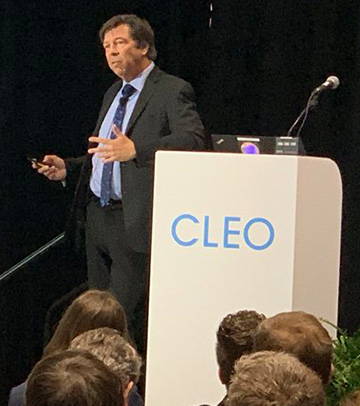
[Image: Getty Images]
The optics and photonics marketplace is a busy place, and feels trends ranging from macroeconomic cycles to “the next big thing.” For an audience at CLEO, OSA’s senior industry adviser, Tom Hausken, walked through market trends in optics and photonics in a special industry focus on Tuesday afternoon. OPN caught up with Tom after the talk to learn more about the analysis and some of the big trends to look for in the next few years.
You’ve been doing these market reports for a while, and some of the highlights find their way into your quarterly OPN column. How does an analysis like this come together?
Tom Hausken: I’d say it’s a bit like doing a Sudoku puzzle in the newspaper. You have some information at the start, but not a lot—and it’s not even clear you have enough to get to conclusions. But you look in different ways—everything from combing public information to just talking to people—and you put the analysis together.
It’s also not clear that there even is a solution to this particular Sudoku puzzle. The ones that you do in the newspaper—somebody knows what the solution is at the start, and they give you just enough information to solve it. But for a market analysis like this, you’re not always sure until you’re done that you’ve created a coherent picture.
Are there things about the photonics business in particular that pose challenges in doing this kind of market analysis?

Tom Hausken at CLEO 2019.
Well, one challenge is that a lot of the companies are private. But that’s not as much of a challenge as you might think. It’s true that by far the largest number of companies in this business are small, private companies, but they actually don’t account for a large share of the employment or the revenues. Those are dominated by the big companies, which are mostly public companies.
Another thing that’s hard to understand, though—and this is where we try to add value—is, you have a photonics company which supplies to a customer, which supplies to another customer and so on. What you really need to know is what’s going on all along that chain; hopefully you can get all the way to the end and make the story coherent all the way back. Where photonics is very vulnerable, I think, is that the firms don’t always understand where everything’s going.
You started out your CLEO talk with a bit about the macroeconomic picture. What are the big macro trends you’re seeing that could affect this industry in the next few years?
Well, one is certainly the role of China. China was not really part of this market up until a few decades ago—and even then, it was seen largely as a customer. Some companies went to China and started manufacturing; it was also a place to do offshore assembly, and so on.

[Image: Getty Images]
But now it’s becoming quite a market and a manufacturer in its own right. Huawei is a $100 billion company; there are a lot of very significant other manufacturers in China as well. Added on top of that, the political situation around the world—with some countries becoming, shall we say, more sensitive on trade issues—can make it all the more confusing. But certainly, China is going to be a big part of the optics and photonics industry going forward.
In the U.S., you noted that there were some positive economic indicators, but also that there were persistent concerns regarding recession. What do those indicators mean for photonics?
A huge part of the optics and photonics business, especially in North America and Europe, goes into capital equipment. And capital equipment is very vulnerable to the economy—when the economy stalls, companies delay decisions on capital equipment, or they trim them back; they’re not building new factories and so forth. That ripples back into the optics and photonics business. It affects consumer products as well, but especially the capital-equipment business.
So that’s one area where you have to be very careful about watching what’s going on with the economy overall in assessing the optics and photonics market. And you also have to look at each sector, because each sector has its own dynamics. Certain things won’t change that much in a downturn—certain government research spends, for example. Or the communications sector may have its own specific dynamics that matter.
And looking at the possible response to any future recession, there’s also less maneuvering room now than there was the last time, in 2008 and 2009. There’s a huge debt load on the U.S. government; corporate debt is very high. There’s less maneuverability on things like interest rates. And the political will may be lacking to do the kinds of things that happened in late 2008 and 2009.
Your talk looked at a variety of photonics sectors. Among the ones that you reviewed, what do you think could be the two or three real standout stories in photonics as we move ahead?
One of the great things about optics and photonics is that there are so many big things happening at any given time. They change over the years—but there always seem to be multiple things that are hot, and opportunities all throughout the business. To pick only two or three means that you’re possibly short-changing others.
That said, integrated photonics certainly is in a very good place right now. It has established itself, and now it can expand into some other applications. Of course it has to prove itself in those new applications, too. But in general, integrated photonics is in a much more established, much better place than it was a few years ago.
At one point in your talk, you noted that integrated photonics is a “real product” now.
Yeah, that’s right. And it’s not shipping in small quantities; it’s going out in some pretty impressive quantities.
![]()
[Image: Getty Images]
A little bit more on the horizon, but also looking very good right now, is lidar. Self-driving cars have all of the challenges you could imagine—from technical challenges and cost issues to social acceptance. And yet it looks like we could solve this problem, if we wanted to, and on some kind of timeline.
Of course, the question is what timeline—and that’s where money is made and lost. Somebody will survive that—and the question becomes which technology, who, when, and what else is needed.
What about sensors?
One of the reasons that sensors don’t get enough attention is that the word encompasses so many different things. There’s not a sensors “market,” really—it’s all the different things that sensors go into.
Sensors do look like a huge opportunity, but it’s often the “box” that the sensor goes into. The optical product itself might not have a high price, a huge profit, or be particularly scalable. But the box can be very valuable.
So that’s an opportunity for a lot of companies—to move up “into the box,” or maybe beyond that, and find opportunities there.
You closed your talk with a nod to “Big Science”—you characterized the present as a golden age for large projects like LIGO, ELI and others. Some of these projects use, and create, a lot of photonic technology. How do you view the impact of things like that on the market—as incubators for innovation, for example, or in other ways?
Well, such projects do represent a market of their own, because selling custom materials and things to these big projects can add up—they buy a lot of stuff just to do the experiments, and they need to have the metrology and other capabilities. So that alone is a market. It’s not as big as the automotive market or the semiconductor market, but it can be big, and can be a nice business.
Also, these big projects produce smart people who can go out and do a lot of different things. If you’re working with ultrafast lasers, then you understand lasers very, very well, and you can go and do amazing things in other places, besides the narrow topic you’re working on. And that’s really valuable for industry—that these projects produce talent that comes out, that knows this stuff, and that can go and do other beautiful things.
And I personally think that doing a fly-by mission to Pluto, or doing the LIGO experiment, is also something that produces a huge social contribution, if you will—it’s inspiring, and it inspires future scientists in this intangible way.
As far as more tangible spin-offs into industry from these projects, though—I think that’s hard to demonstrate, and I don’t think that people should focus on that. I think the other benefits I mentioned are big enough and important enough, and the spinoffs into industry—if you get them, well, that’s a great side benefit.
